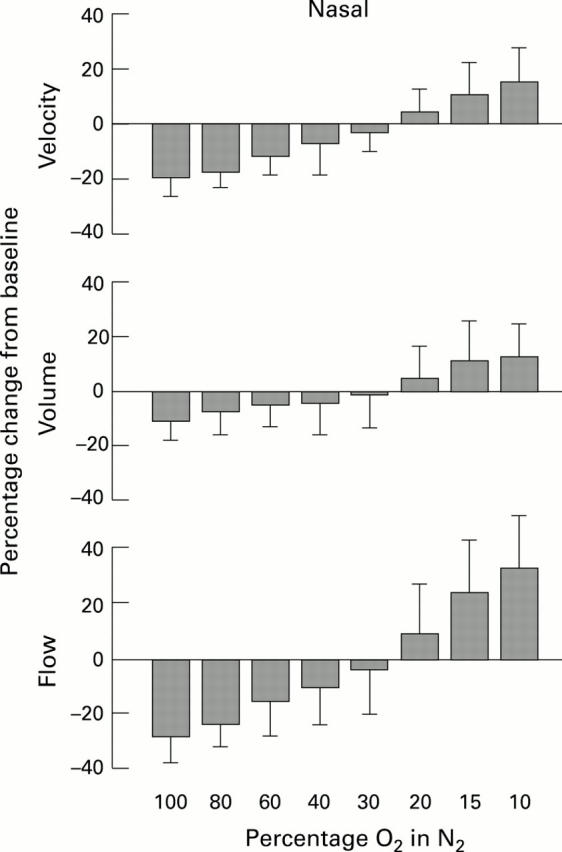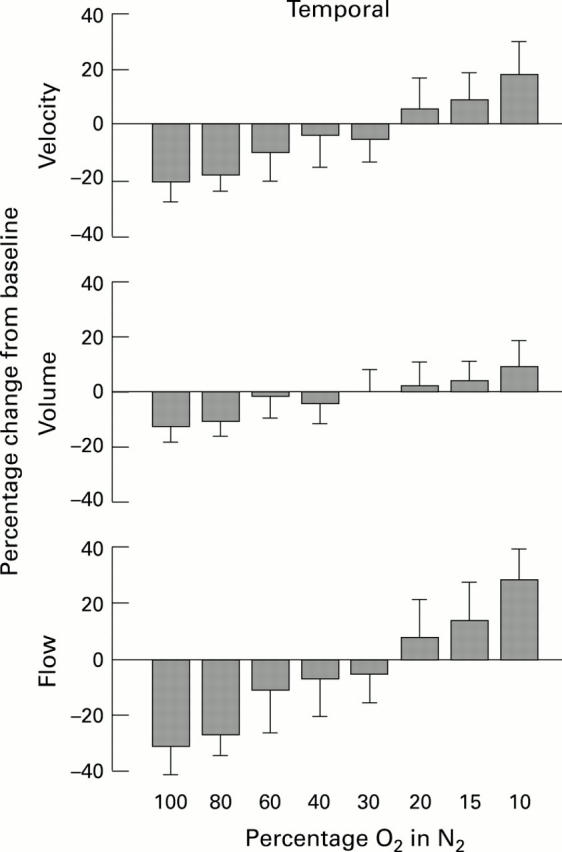Abstract
AIMS/BACKGROUND—Recently a commercially available scanning laser Doppler flowmeter has been produced, which provides two dimensional maps of the retinal perfusion. The aim of the present study was to investigate the reproducibility and the sensitivity of these measurements. METHODS—16 healthy subjects were randomised to inhale different gas mixtures of oxygen and nitrogen in a double blind crossover study. The following gas mixtures of oxygen and nitrogen were administered: 100% oxygen + 0% nitrogen, 80% oxygen + 20% nitrogen, 60% oxygen + 40% nitrogen, 40% oxygen + 60% nitrogen, 30% oxygen + 70% nitrogen, 20% oxygen + 80% nitrogen, 15% oxygen + 85% nitrogen, and 10% oxygen + 90% nitrogen. Retinal haemodynamic variables and systemic haemodynamics were measured during all inhalation periods. Recordings under resting conditions were performed three times to calculate intraclass coefficients. RESULTS—In two subjects we did not obtain technically adequate results. A dose dependent change in retinal blood flow during graded oxygen breathing was observed (p < 0.001). During 100% oxygen breathing blood flow decrease was between 29% and 33%, whereas blood flow increase was between 28% and 33% during inhalation of 10% oxygen + 90% nitrogen. CONCLUSIONS—Scanning laser Doppler flowmetry has an acceptable reproducibility and is appropriate for description of the effect of graded changes in PO2 on retinal haemodynamics. The main problems with the system are the large zero offset, the fixation during retinal scanning, and the neglect of blood flow changes during the cardiac cycle.
Full Text
The Full Text of this article is available as a PDF (133.7 KB).
Figure 1 .

The effect of different mixtures of O2 and N2 on scanning laser Doppler flowmetry variables in the macula. Results are presented as percentage change from baseline (means (SEM)).
Figure 2 .

The effect of different mixtures of O2 and N2 on scanning laser Doppler flowmetry variables in an area approximately 5 degrees nasal. Results are presented as percentage change from baseline (means (SEM)).
Figure 3 .

The effect of different mixtures of O2 and N2 on scanning laser Doppler flowmetry variables in an area approximately 5 degrees temporal. Results are presented as percentage change from baseline (means (SEM)).
Selected References
These references are in PubMed. This may not be the complete list of references from this article.
- Arend O., Harris A., Sponsel W. E., Remky A., Reim M., Wolf S. Macular capillary particle velocities: a blue field and scanning laser comparison. Graefes Arch Clin Exp Ophthalmol. 1995 Apr;233(4):244–249. doi: 10.1007/BF00183599. [DOI] [PubMed] [Google Scholar]
- Fallon T. J., Maxwell D., Kohner E. M. Retinal vascular autoregulation in conditions of hyperoxia and hypoxia using the blue field entoptic phenomenon. Ophthalmology. 1985 May;92(5):701–705. doi: 10.1016/s0161-6420(85)33978-7. [DOI] [PubMed] [Google Scholar]
- Gherezghiher T., Okubo H., Koss M. C. Choroidal and ciliary body blood flow analysis: application of laser Doppler flowmetry in experimental animals. Exp Eye Res. 1991 Aug;53(2):151–156. doi: 10.1016/0014-4835(91)90068-p. [DOI] [PubMed] [Google Scholar]
- Hamard P., Hamard H., Dufaux J., Quesnot S. Optic nerve head blood flow using a laser Doppler velocimeter and haemorheology in primary open angle glaucoma and normal pressure glaucoma. Br J Ophthalmol. 1994 Jun;78(6):449–453. doi: 10.1136/bjo.78.6.449. [DOI] [PMC free article] [PubMed] [Google Scholar]
- Kramer M. S., Feinstein A. R. Clinical biostatistics. LIV. The biostatistics of concordance. Clin Pharmacol Ther. 1981 Jan;29(1):111–123. doi: 10.1038/clpt.1981.18. [DOI] [PubMed] [Google Scholar]
- Michelson G., Groh M., Langhans M., Schmauss B. Zweidimensionale Kartierung der retinalen und papillären Mikrozirkulation mittels Scanning-Laser-Doppler-Flowmetrie. Klin Monbl Augenheilkd. 1995 Sep;207(3):180–190. doi: 10.1055/s-2008-1035365. [DOI] [PubMed] [Google Scholar]
- Michelson G., Langhans M. J., Groh M. J. Clinical investigation of the combination of a scanning laser ophthalmoscope and laser Doppler flowmeter. Ger J Ophthalmol. 1995 Nov;4(6):342–349. [PubMed] [Google Scholar]
- Michelson G., Schmauss B., Langhans M. J., Harazny J., Groh M. J. Principle, validity, and reliability of scanning laser Doppler flowmetry. J Glaucoma. 1996 Apr;5(2):99–105. [PubMed] [Google Scholar]
- Pakola S. J., Grunwald J. E. Effects of oxygen and carbon dioxide on human retinal circulation. Invest Ophthalmol Vis Sci. 1993 Sep;34(10):2866–2870. [PubMed] [Google Scholar]
- Rassam S. M., Patel V., Chen H. C., Kohner E. M. Regional retinal blood flow and vascular autoregulation. Eye (Lond) 1996;10(Pt 3):331–337. doi: 10.1038/eye.1996.69. [DOI] [PubMed] [Google Scholar]
- Riva C. E., Grunwald J. E., Sinclair S. H. Laser Doppler Velocimetry study of the effect of pure oxygen breathing on retinal blood flow. Invest Ophthalmol Vis Sci. 1983 Jan;24(1):47–51. [PubMed] [Google Scholar]
- Riva C. E., Harino S., Petrig B. L., Shonat R. D. Laser Doppler flowmetry in the optic nerve. Exp Eye Res. 1992 Sep;55(3):499–506. doi: 10.1016/0014-4835(92)90123-a. [DOI] [PubMed] [Google Scholar]
- Riva C., Ross B., Benedek G. B. Laser Doppler measurements of blood flow in capillary tubes and retinal arteries. Invest Ophthalmol. 1972 Nov;11(11):936–944. [PubMed] [Google Scholar]
- Schmetterer L., Lexer F., Findl O., Graselli U., Eichler H. G., Wolzt M. The effect of inhalation of different mixtures of O2 and CO2 on ocular fundus pulsations. Exp Eye Res. 1996 Oct;63(4):351–355. doi: 10.1006/exer.1996.0125. [DOI] [PubMed] [Google Scholar]
- Schmetterer L., Wolzt M., Lexer F., Alschinger C., Gouya G., Zanaschka G., Fassolt A., Eichler H. G., Fercher A. F. The effect of hyperoxia and hypercapnia on fundus pulsations in the macular and optic disc region in healthy young men. Exp Eye Res. 1995 Dec;61(6):685–690. doi: 10.1016/s0014-4835(05)80019-3. [DOI] [PubMed] [Google Scholar]
- Sponsel W. E., DePaul K. L., Zetlan S. R. Retinal hemodynamic effects of carbon dioxide, hyperoxia, and mild hypoxia. Invest Ophthalmol Vis Sci. 1992 May;33(6):1864–1869. [PubMed] [Google Scholar]


